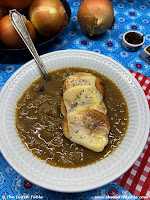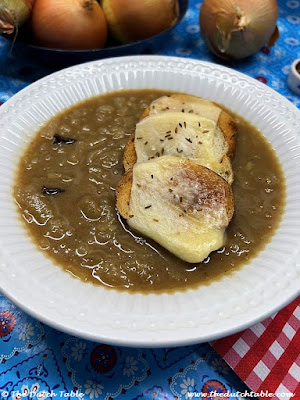The fastest way to describe s
aucijzenbroodjes is to say they're like
worstenbroodjes, sausage rolls, but fancier. Instead of bread dough encasing the ground meat sausage, a saucijzenbroodje wraps the meat in a delicate pillow of crisp, flaky puff pastry. The common
worst gets bread dough, the
saucijs (a fancier name for sausage, from the French
saucisse) gets the buttery pastry.
It's the culinary version of a famous Dutch saying: "
Er zijn werkpaarden en er zijn luxe paarden"(There are work horses and there are luxury horses). The
saucijzenbroodje is definitely a luxury horse!
Saucijzenbroodjes are readily available, warm, at Dutch train stations, in fast food places and often consumed for lunch with a salad or a cup of soup. The puff pastry makes it a fairly rich treat (and a bit messy if you're eating it on the go!) but is also very versatile. This recipe makes a basic, pretty standard flavored roll, but you are welcome to add your favorite spices to the mix. How about shoarma flavors, or a spicy hint of curry? It's your choice!
This is also a great treat to share with friends at a potluck, as a snack for TV watching, or for lunch with a salad.
Saucijzenbroodjes

8 squares of 5 x 5 inches frozen puff pastry
1 lb ground beef
1 tablespoon fresh parsley, minced
1/2 teaspoon onion powder
1/2 teaspoon ground black pepper
Pinch of nutmeg
1 teaspoon salt
1 egg, beaten
2 tablespoons panko or bread crumbs
Lay the puff pastry squares on the counter to defrost. Mix the meat, parsley and the spices together, add half of the beaten egg and all of the breadcrumbs. Mix and roll into a large sausage. Divide it in eight equal parts and roll each one into a log, about 4.5 inches long, a little shorter than the length of the puff pastry square.
Heat the oven to 425 F. Place the sausage on one half of the pastry square, brush a little egg on the edges and fold over the other half. Press the long edge shut with a fork. After you've folded all eight pastry squares, brush the tops with the rest of the beaten egg. Line a baking sheet with parchment paper, put the
saucijzenbroodjes on top and bake in the oven for approximately 20 minutes or until golden brown.
Best eaten hot or warm - keep in fridge and consume within 24 hours.
My Amazon selections for this recipe
As an Amazon Associate I earn from qualifying purchases.
De snelste manier om een saucijzenbroodje te beschrijven is door te zeggen dat ze op
worstenbroodjes lijken, maar dan sjieker. In plaats van brooddeeg om het worstje van gehakt, omarmt het saucijzenbroodje het vlees in een broos kussen van knapperig, luchtig bladerdeeg. De gewone worst krijgt brooddeeg, de saucijs (een sjiekere naam voor worst, van het Frans
saucisse) krijgt het smeuïge korstdeeg.
Het is de culinaire versie van het bekende Nederlandse spreekwoord "
Er zijn werkpaarden en er zijn luxe paarden". Het
saucijzenbroodje is beslist een luxe paardje!
Saucijzenbroodjes zijn kant-en-klaar verkrijgbaar, warm, op Nederlandse treinstations, in cafetarias en worden vaak gegeten tijdens het middagmaal met een salade of een kopje soep. Het bladerdeeg zorgt ervoor dat het best wel een machtige versnapering is (en kruimelt nogal als je hem uit het vuistje eet!) maar is ook vrij veelzijdig. Dit recept is voor een standaard saucijzenbroodje, maar u kunt er natuurlijk uw eigen draai aan geven. Wat dacht u van shoarma kruiden, of een pittige kerriesmaak? Kiest u maar!
Dit is ook een lekkere traktatie om te delen met vrienden tijdens een gezamenlijk etentje, als een snack tijdens het televisie kijken, of voor het middagmaal met een salade.
Saucijzenbroodjes

8 plakjes bladerdeeg van 12 x 12 cm
500 gram rundergehakt
1 eetlepel verse peterselie, fijngehakt
1/2 theelepel uienpoeder
1/2 theelepel zwarte peper, gemalen
Mespuntje nootmuskaat
1 theelepel zout
1 ei, geklopt
2 eetlepels panko of broodkruimels
Leg de plakjes bladerdeeg op het aanrecht om ze te ontdooien. Meng het vlees met de peterselie en de specerijen, voeg de helft van het ei toe en de volledige broodkruimels. Meng het nogmaals, en rol het dan in een grote worst. Verdeel het in acht gelijke stukken en rol ieder stuk uit tot een stammetje, ongeveer 10 cm, iets korter dan de lengte van het bladerdeeg.
Heat the oven to 225C. Plaats ieder worstje op de ene helft van het plakje bladerdeeg, strijk een beetje ei op de randjes en vouw de andere helft er over heen. Druk de lange kant vast met de tanden van een vork. Nadat u alle acht plakjes bladerdeeg gevouwen heeft, strijk de bovenkant dan in met de rest van het ei. Leg een blaadje bakpapier op een bakplaat, leg de
saucijzenbroodjes er op en bak ze in de oven voor ongeveer 20 minuten, of totdat ze mooi goudbruin zijn.
Het lekkerste warm uit de oven of lauw gegeten - bewaar ze anders in de koelkast en gebruik ze binnen een dag.











































